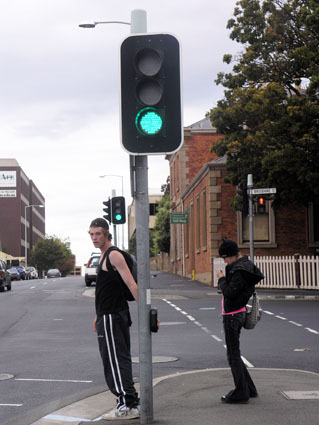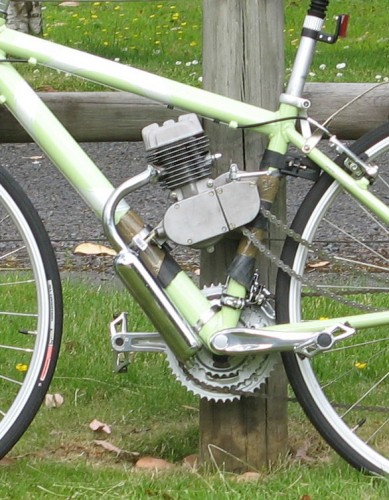The need to cut carbon emissions from transport has put a premium on innovative thinking about traffic and how we move about on our roads. [14 March 2008 | Peter Boyer]
Where would we be today without the car?
It’s central to life in the developed world. It determines where we live and work, how we fill our leisure time, how we relate to others near and far. It’s shaped our sprawling cities and towns, taking up a lot of our public funds for road-building and otherwise dealing with traffic congestion.
And it’s put a sizeable tonnage of carbon into the air.
We’re scrambling to meet this latter challenge with electric-hybrid cars and biofuels, a subject I’ll return to in coming weeks. But for many reasons – climate and other – we need urgently to take a fresh look at the kinds of transport, and transport infrastructures, we need to support.
Hobart geographer Bob Cotgrove offers the dismal prediction that the desire for personal freedom will quadruple the world’s car fleet by 2050. By this time, scientists are telling us, our carbon emissions will need to be cut by 90 per cent.
Such wildly disparate demands should spur us into action. In the first instance, we should be minimising the cost to our pockets and the environment of managing traffic congestion.
There can be no better contributor to this than traffic lights made from light-emitting diodes with the astonishing economies they offer, developed and marketed by a Tasmanian company (see story below).
But in the longer term Cotgrove’s prediction about extravagantly inefficient private cars can’t be allowed to happen. Some locked-on car owners will oppose any compromise to personal freedom, but our future will depend on coming together – not glorious, futile isolation.
A climate-friendly transport policy would provide more regular, flexible and comfortable public services going to more destinations, parking stations near suburban bus terminals – and disincentives for use of private vehicles, especially those with no passengers, such as fees for bringing cars into city centres.
Commuters needing personal freedom should have greater incentives to walk or cycle with improved – and many more – foot and cycle paths.
Regarding which, engineer Greg Clausen (see story below) has a solution for Tasmanian commuters struggling with the idea of riding a bike up steep hills. He’s developed a way of fitting a tiny engine to a standard pushbike that enables him to commute with relative ease between his Fern Tree home and his workplace in Glenorchy – at 160 km per litre!
From such small beginnings grow mighty things.
Tiny lights that save megawatts
Tiny light-emitting diodes, or LEDs, are changing the way we light up our lives. One of the early beneficiaries will be our traffic control systems, and a leading world player in this transformation is a Hobart-based company, Solux.
LED traffic lights use about one-seventh the power of conventional lights and last about ten times longer
Solux has developed a unique low-voltage LED traffic light system that can operate using about a seventh the power of conventional lights.
Tasmania has around 15,000 traffic lights, each conventionally 70 watts, operating at 300-odd intersections around Tasmania. That’s a lot of electricity.
Solux’s lights, each using about 100 LEDs, run at 10 watts for red and green lights and 14 watts for amber – and last about ten times as long. That’s a huge saving in electricity and maintenance.
But first they have to be installed. Since late 2006 only one intersection in Tasmania – at the corner of Brisbane and Campbell Streets in Hobart – has been completely controlled by LED lights. This week will see a second, at Launceston’s Canning and Bathurst Streets, come into operation.
What most sets Solux LED traffic lights apart from others is their 42-volt operation (as against the current 240 volts), making them safe for maintenance and in the event of traffic accidents.
Solux director Mike Austin said the lights have been designed so that they fit into existing housing – another cost saving for government.
LED solid-state lights have been used for some years in portable lighting, but they have huge potential for domestic and even industrial-strength lighting. New white-light LED prototypes have a lighting efficiency exceeding the best fluorescent lights.
This is a revolution that can’t come soon enough.
Pedal power plus
Three years ago, realising that the twin challenges of peak oil and climate change would change our way of life, Greg Clausen set out to discover the most environmentally responsible way to travel between his mountain home in Fern Tree and his workplace.
Greg Clausen’s Hybri-Ped engine installed on a standard pedal bike
In the process he became an inventor, and recently filed an international patent application for his “Hybri-Ped” transmission system, a way of having an engine on a bicycle while still being able to pedal – a genuine hybrid powered bicycle.
Pedal purists may recoil at the idea of putting a motor on a bike, but a comparison of Greg’s fuel consumption with even the most economical four-wheeler might make them think again.
In more than 2,500 km over nine months commuting between Fern Tree and Glenorchy City Council where he is an engineer, Greg’s bicycle has consumed only 16 litres of fuel. That’s around $30.00, little more than the cost of a one-week Metro bus ticket.
In conventional terms, his fuel consumption is just over 0.6 litres per 100 kilometres, around one-tenth that of a small car.The Hybri-Ped allows him to pedal when it suits him. On working mornings he pedals from Fern Tree to Glenorchy via the Intercity Cycleway – the perfect start to the day, he says. On the return journey, he pedals to Hobart and then starts the engine for the climb to Fern Tree.
The motor, which adds only 10 kg to total weight, acts as a governor that prevents the Hybri-Ped going above 40 km/h, so handling and braking are the same as for any cyclist. The worst hazard for Greg, as for a conventional cyclist, is speeding cars.
Curiously, the Hybri-Ped can’t be classified under current Australian motor vehicle design rules. Greg is seeking to have the rules changed so that his hybrid pedal-motor bicycle can find a permanent place on the road.


